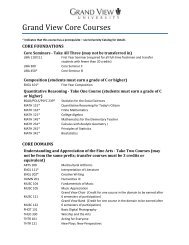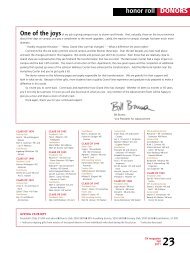MUNINN
MUNINN - Grand View University
MUNINN - Grand View University
- No tags were found...
You also want an ePaper? Increase the reach of your titles
YUMPU automatically turns print PDFs into web optimized ePapers that Google loves.
The Treaty of London (1838) <strong>MUNINN</strong> Volume 2 (2013)of France. 33 No matter what the reasoning was behind eliminating theseprevious treaties at Versailles in 1919, one thing is clear that the treatiesthat “guaranteed” the “neutrality” of Belgium and Luxembourg nolonger had a voice at the peace table.In conclusion, Belgium was clinging to an illusion that thetreaty which protected them since 1839 could be matched to a fortifiedborder with Germany and an expanded empire in Africa that would beenough to keep them from invasion. The reality of the matter is thatutility of the Treaties of London had no power left to guaranteeBelgium’s neutrality. Lord Salisbury, who was then British primeminster, thought that the treaty was no longer viable in 1887, and wentas far as contemplating the termination of the treaty, largely due toBelgian expansion of territory in Africa. 34 The Germans were“convinced that Belgian neutrality had been forfeited long ago,” withtheir fortifications. Even France, for a time, entertained the notion of aplan to invade Belgium as late as 1912. 35 Sadly, in the end, everyoneknew the treaty was nothing more than a piece of paper. But no one hadthe courage to acknowledge this prior to the invasion. It did not matterif the neutrality guaranteed by the 1839 treaty was no longer there.Because, under the first article of the Hague Convention of 1907: “Theterritory of neutral Powers is inviolable.” It would in effect end theneed of having treaties that guarantee neutrality from that pointforward. 36 But the Edwardian Hague Convention did not have the sameinsistence that Britain save Belgium as the Victorian London Treaty, sotherefore the latter was twisted into new utility in 1914 and 1919. Thelessons learned from these events showed us that jus gentium is able tobe redefined in each generation. However, the point is that thesetreaties have a finite shelf life, especially within the context of wordslike “guarantee” or” neutrality.” In the end, what killed the treaty of1839 was not the invasion by Germany in 1914 or the HagueConvention of 1907, or even the Treaty of Versailles in 1919. It was thefact that powers like Britain, France, and Germany no longer heldconsensus over its use after Belgium used it to perpetuate an economicand military advantage. When that happened, the treaty became a pieceof paper.33Remak, p 127-129. Schlieffen truly felt there would be “no important consequencesother than protests”34Montgelas, p 7.35Albrecht-Carrie, 189-190. The plan was proposed by Joffre and eventually rejected;also see student paper, “The Alleged Military Alliance between Belgium and GreatBritain,” University of Virginia, n.d., for further discussion.http://faculty.virginia.edu/setear/students/jcs/neutrality4.html;36International Humanitarian Law: Hague Convention V, 1907. International Committeeof the Red Cross. www.icrc.org/ihl.nsf/full/200?opendocument32







